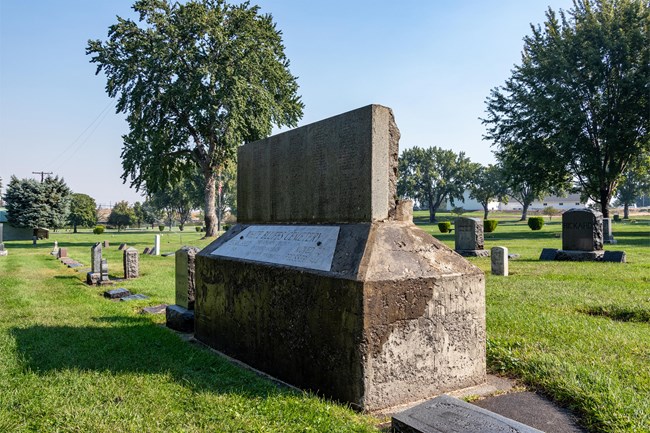Last updated: April 4, 2023
Article
Cemetery Removal

NPS
Article written by Zach White
When the Hanford Site construction began in 1943, several cemeteries existed in the Priest Rapids Valley. Most of these cemeteries were not in areas of construction and would be left undisturbed; however, the White Bluffs Cemetery laid in the path of development. That cemetery was forced to relocate, along with several family burial plots, for what the residents knew of at the time as the “Hanford Engineer Works Project.” The White Bluffs Cemetery Association did not oppose the moving of the cemetery, but there was much internal debate, as well as negotiations with the government, about where the bodies in the White Bluffs Cemetery would be moved to. The federal government offered to provide the mortician to move the bodies and pay for the slots for the bodies in the new cemetery they were moved to. There were approximately 1,500 Native graves in the Hanford Works area, but the majority of them were unmarked and their exact locations unknown.
Edmund Anderson was the President of the White Bluffs Cemetery Association. In a meeting of the Cemetery Association on April 5th, 1943, the association decided that Anderson would be given the power to act on behalf of the entire association when it came to the matter of moving the bodies. Mr. Anderson had three family members buried in the White Bluffs Cemetery, his wife, mother, and daughter. The original preference of the community was that the bodies be moved to the cemetery in Kennewick, but the government nixed that idea because the Kennewick Cemetery raised their prices to $50 per plot from $20 dollars per plot and the government was not willing to pay the difference in price. There were also rumors of the bodies being relocated to Pasco, but the members of the cemetery association and families with loved ones in the cemetery had little enthusiasm for this location. Mrs. Opal Gregory wrote a letter to the White Bluffs Cemetery Association on May 6th, 1943, in which she said, “I wrote them to see if they would move our peoples’ bodies to Seattle as we certainly did not want them taken to Pasco (I had heard they were talking of taking the cemetery there.) At least we hope not.” It was decided in a meeting of the cemetery association on May 1st, 1943, that the bodies would be moved to a cemetery in Prosser. If families were unhappy with the selected cemetery in Prosser they could get in contact with the contracted undertaker and have the bodies moved to the location of their choice, but any additional cost would not be covered by the government if a family chose to move their family members to any other cemetery. The majority of families with loved ones in the White Bluffs Cemetery decided to have their family members moved to the selected site in Prosser.
On May 29 1944, Edmund Anderson received a letter from the War Department notifying him that the move of the White Bluffs Cemetery had been completed. Hamilton’s Mortuary of Vancouver handled the removal and reinterment of the bodies. Joseph Shauhnessy, the owner of the mortuary firm, was personally in charge of all reinternments of the bodies into the Prosser Cemetery. The monuments and markers from the White Bluffs Cemetery were moved to the new location by the Otto Schumann Monument Co. of Portland, OR. Any bodies that did not have a marker at the previous cemetery were marked with concrete markers set flush with the ground which had the person’s name indented with sunken letters. Edmund Anderson personally supervised both the exhumations and reinternments of the bodies. All of the bodies were placed in new boxes with all the personal items found in their graves before being reinterred. Along with providing plots for the move of the White Bluffs Cemetery the Prosser Cemetery would provide perpetual care for the graves.
Family members were given the opportunity to reserve plots at the Prosser Cemetery for $20 so that when they eventually died themselves, they could be buried next to their family member. The final district court ruling for the removal of the White Bluffs Cemetery claims that all known relatives of those relocated to Prosser Cemetary were sent letters informing them of the where their relatives’ bodies were moved to and details of the reinterment of the bodies. The government inevitably missed several notifications as Edmund Anderson continued to receive letters from people inquiring about the whereabouts of their relatives’ bodies long after the finalization of the cemetery move. A few families received $1 as compensation for the seizure of their family burial plot. In 1997, there were still relatives looking for their family members. The great grandson of George Winfield Shaw sent an email to the Hanford-White Bluffs Pioneer Association inquiring about the location of the body of his great grandfather. His family moved to Oregon before the Manhattan Project forced the residents of the Priest Rapids Area to relocate. The family was never informed of the cemetery move and lost track of the body of George Winfield Shaw. Even more than fifty years later families were still facing open questions about the final resting place of their relatives, and this was only one small part of the uprooting the residents in the Hanford and White Bluffs faced because of the Manhattan Project.
- Gregory, Opal. Letter to Edmund Anderson. “Letter to White Bluff Cemetery Association,” May 16, 1943.
- Letter to James Shaw. White Bluffs Cemetery, May 19, 1997.
- Sullen, Howard G. Letter to Edmund Anderson. “Cemetery Move Confirmation.” Prosser, Washington, May 29, 1944.
- United States of America vs. Clements P. Alberts, et al., White Bluffs Cemetery Association, a corporation, et al., Defendants. (District Court of the United States for the Eastern District of Washington Southern Division May 15, 1945).
